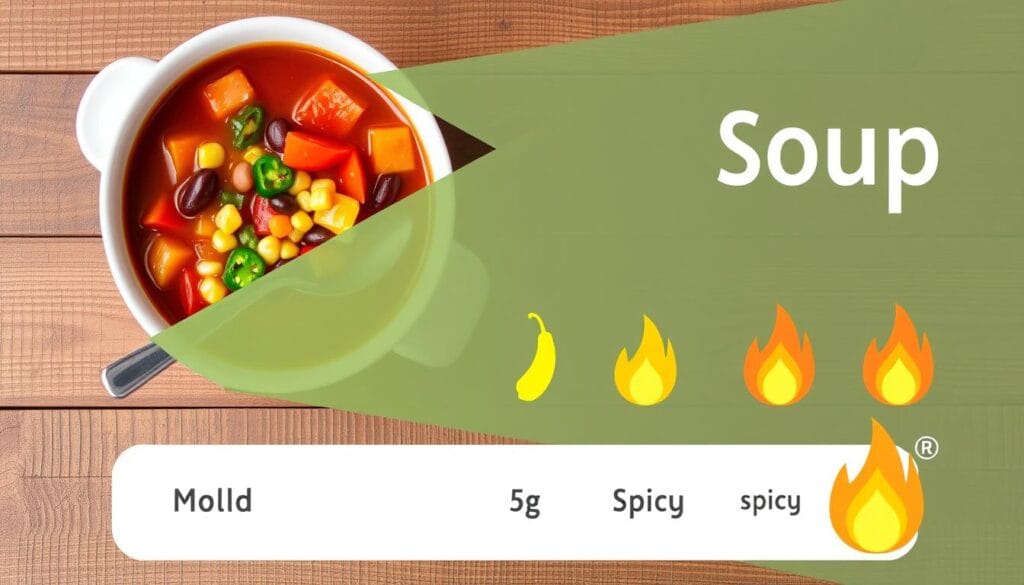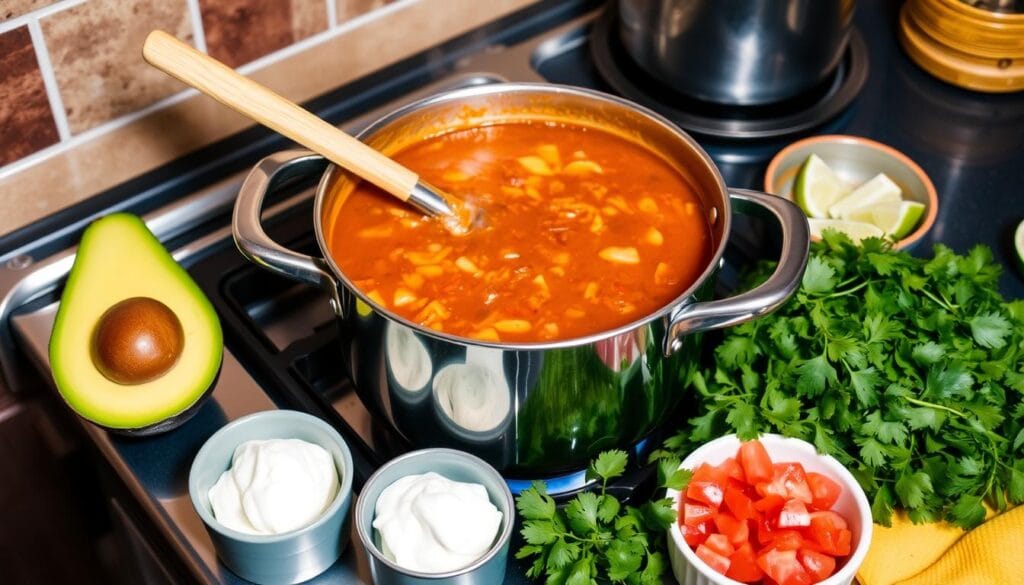Every home cook has faced the challenge of a too-spicy dish. I once turned a tasty taco soup into a fiery mess, and my family’s shocked faces were a clear sign. This moment made me determined to learn how to reduce heat without losing flavor.
Making a balanced taco soup is an art. It’s all about controlling the heat while keeping the authentic Mexican taste. Whether you use ground turkey, beef, or chicken, the goal is to keep it flavorful and spicy.
Key Takeaways
- Understand the sources of heat in your taco soup
- Learn multiple techniques to reduce spiciness
- Preserve the authentic Mexican flavor profile
- Customize your soup for different heat tolerances
- Transform a potentially too-spicy dish into a crowd-pleaser
Understanding Heat Levels in Taco Soup
Making a hearty taco soup needs a balance of flavors and heat. If the spice is too much, it can ruin your weeknight dinner. It’s important to keep it family-friendly.

Spicy ingredients are what make taco soup great. We’ll look at why it can get too hot and how to adjust the flavor.
Common Spicy Ingredients in Taco Soup
Taco soup often has ingredients that add heat:
- Fresh chili peppers
- Cayenne pepper
- Hot sauce
- Chili powder
- Red pepper flakes
Why Soups Can Become Too Spicy
Several things can make your soup too spicy:
- Different strengths of ingredients
- Too much spice by accident
- Using very hot peppers
- Ingredients can vary in intensity
Identifying Your Soup’s Heat Level
To check your taco soup’s spiciness, try these steps:
- Start with a small taste
- Look for signs of heat
- Check if your heart beats faster
- See if you sweat a lot
“Spice is nice, but balance is key in creating a delicious taco soup that everyone can enjoy.”
Knowing how heat works will help you make a taco soup everyone loves. It’s perfect for a weeknight dinner.
Quick Solutions for Reduce Heat Taco Soup

Don’t worry if your taco soup gets too spicy! There are quick and simple ways to make it less hot. These methods work for both high-protein and vegetarian soups. They help keep your meal from being too spicy.
“Balancing spice is an art, not a science” – Culinary Experts
Here are some easy ways to cool down your taco soup:
- Dilute the soup by adding more broth or water
- Incorporate dairy products to neutralize spiciness
- Use acidic ingredients to balance flavors
- Add small amounts of sweeteners
Knowing how to reduce heat can turn a spicy soup into a great meal. It’s all about doing it right, so the soup still tastes good.
| Heat Reduction Method | Effectiveness | Flavor Impact |
|---|---|---|
| Adding Broth | High | Minimal |
| Dairy Addition | Very High | Creamy Enhancement |
| Acidic Ingredients | Medium | Flavor Complexity |
| Sweetener | Low | Subtle Transformation |
Pro tip: Always add heat-reduction ingredients gradually and taste as you go to maintain the soup’s integrity. Your goal is to create a balanced, enjoyable meal that everyone can appreciate, regardless of their spice tolerance.
The Dairy Method: Adding Creamy Components
Making a tasty taco soup that’s not too spicy is all about clever tricks. Dairy products are great for cooling down the heat and making your meal creamy. When you’re cooking up a Mexican-flavored soup, knowing how to use dairy can make all the difference.
Dairy is your best friend when you’re dealing with spicy taco soup. Full-fat dairy products not only tame the heat but also make your dish feel fancy.
Types of Dairy to Use
- Sour cream – provides tangy coolness
- Heavy cream – adds smooth richness
- Cream cheese – creates extra creaminess
- Whole milk – lightens heat while maintaining consistency
- Plain yogurt – offers a protein-packed cooling effect
How to Incorporate Dairy Without Curdling
To avoid dairy from curdling, keep these tips in mind:
- Reduce soup temperature before adding dairy
- Stir gradually and consistently
- Use room temperature dairy products
- Add dairy at the end of cooking
Non-Dairy Alternatives for Cooling
If you’re not into dairy, here are some great alternatives that work well with Mexican flavors:
- Coconut milk – provides creamy texture
- Almond milk – offers light cooling effect
- Cashew cream – creates smooth consistency
“The key to a perfect taco soup is balance – between heat, flavor, and creaminess.” – Culinary Expert
By using these dairy tips, you’ll make a taco soup that’s both tasty and easy to handle. Remember, a little dairy can make a big difference in your soup.
Balancing Flavors with Acidic Ingredients
Making a spicy one-pot meal family-friendly is simple. Acidic ingredients help tame the heat while keeping flavors strong in taco soup.
Need to tone down the soup’s heat? Try these acidic options:
- Lime juice: A classic Mexican-inspired addition
- Lemon juice: Bright and zesty flavor neutralizer
- Vinegar: White or apple cider varieties work best
Pro tip: Start with small amounts, typically 1 tablespoon at a time. This helps balance flavors without overpowering the soup.
“Acidity cuts through heat like a culinary magic trick” – Professional Chef Recommendation
Acidic ingredients match different taco soup styles. Lime is great for seafood soups, while vinegar adds a kick to creamy ones. Your taste buds will tell you what’s right.
Be precise when adding acidic ingredients. Add a little at a time, tasting as you go. This way, your dinner stays tasty and enjoyable for everyone, turning a spicy soup into a hit with your family.
Using Starches to Absorb Heat
Starches can be a game-changer for your spicy taco soup. They not only cool down the heat but also add texture and nutrition. This makes your meal prep a breeze.
Starches act like heat sponges, soaking up spicy flavors. They’re a great choice for those who want to tame the heat without losing protein. Plus, they’re perfect for vegetarians.
Best Types of Starches to Add
- Potatoes: Cubed or mashed, absorb heat effectively
- Rice: White or brown rice can neutralize spiciness
- Pasta: Small shapes work best for soup consistency
- Beans: Add protein while reducing heat
- Masa harina: Traditional Mexican thickener
Proper Ratios for Starch Addition
When adding starches, start small:
- Begin with 1/4 cup of starch per 2-3 cups of soup
- Stir thoroughly and let simmer for 10-15 minutes
- Taste and adjust heat levels gradually
“The key is balance – starches should enhance, not overwhelm your soup’s flavor profile.”
With the right amount of starches, you can turn a spicy taco soup into a cozy, balanced meal. It’s something everyone can enjoy.
The Dilution Solution: Adding More Base Ingredients
When your taco soup gets too spicy, there’s an easy fix. Adding more base ingredients can cool it down without losing the tasty Mexican flavors. This way, you can turn a fiery dish into a balanced meal.
To make your taco soup less spicy, try these steps:
- Add extra broth to spread out the spiciness
- Incorporate additional protein like shredded chicken or beans
- Mix in more vegetables to absorb and distribute heat
The goal is to keep the soup’s flavor but make it less spicy. Add about 1/2 cup of extra ingredients for every cup of original soup.
“Dilution is the solution to heat pollution in your taco soup!” – Home Cooking Wisdom
Here’s a quick guide for dilution ingredients:
| Ingredient Type | Heat Reduction Potential | Flavor Impact |
|---|---|---|
| Chicken broth | High | Neutral |
| Black beans | Medium | Rich |
| Diced potatoes | High | Mild |
| Bell peppers | Medium | Sweet |
Dilution isn’t just about cooling down the soup. It’s about making a flavorful dish that everyone can enjoy. Try different ingredients to find your ideal balance.
Sweet Elements to Counter Spiciness
Turning a spicy taco soup into a tasty weeknight dinner is easy. Sweet ingredients can help tame the heat. This way, you get a meal that’s good for everyone.
When your taco soup gets too hot, natural sweeteners can save the day. The trick is to add them just right. This way, you keep the soup’s true taste without losing it.
Natural Sweetener Options
Here are some natural sweeteners to help cool down the spice:
- Honey: Provides complex sweetness and depth
- Maple syrup: Adds rich, caramel-like undertones
- Agave nectar: Offers mild, smooth sweetness
- Brown sugar: Introduces a warm, molasses-like flavor
Proper Sweetener Measurements
When adding sweeteners, be precise. Follow these tips:
- Start with 1 teaspoon of sweetener per 2 cups of soup
- Stir and taste gradually
- Adjust a little at a time to avoid too much sweetness
- Go for balance, not too sweet
“The art of cooking is finding harmony between flavors, not drowning one with another.” – Chef’s Wisdom
The aim is to make a taco soup that everyone will love. Sweet elements can turn a spicy dish into a cozy, tasty dinner. It’s perfect for any weeknight.
Professional Tips for Heat Adjustment
Professional chefs know that reducing heat in taco soup needs care. When you’re making your meal prep, be patient and precise with spice reduction. Gradual adjustments are key to maintaining the soup’s rich flavor profile.
Looking for a high-protein option? Here are some expert tips:
- Taste your soup often as you reduce the heat
- Try using nut butters like almond or peanut butter to soften the spiciness
- Add neutral-flavored proteins to balance out the heat
Vegetarian option fans can use similar methods with plant-based proteins. Adding creamy elements or starchy ingredients works well with different proteins.
“The secret to perfect taco soup is balance – not elimination of flavor” – Professional Chef Recommendation
When dealing with spicy ingredients, keep these pro tips in mind:
- Begin with small changes
- Add cooling ingredients little by little
- Let the flavors mix between each change
By using these professional methods, you can turn a too spicy taco soup into a balanced, tasty dish that everyone will love.
Serving Suggestions for Spicy Taco Soup
Turning your one-pot meal into a great dining experience needs the right sides. A good side dish or garnish can make your easy Mexican recipe better. It also helps control the soup’s heat.
Complementary Side Dishes
Choosing the right sides for your taco soup makes for a balanced meal. Here are some top picks:
- Cornbread: A classic that cools down spicy flavors
- Tortilla chips: Great for dipping and adding crunch
- Fresh green salad: Offers a crisp contrast to the warm soup
- Garlic bread: Adds a savory touch to the Mexican dish
- Refried beans: Boosts the protein in your meal
Garnish Options for Heat Control
Choosing the right garnishes can enhance flavor and control spiciness:
| Garnish | Heat Controlling Effect |
|---|---|
| Sour cream | Neutralizes spiciness |
| Shredded cheese | Adds creamy texture |
| Diced avocado | Provides cooling element |
| Chopped cilantro | Adds fresh flavor |
| Lime wedges | Balances heat with acidity |
Pro tip: Let guests customize their soup with these garnishes. This way, everyone can enjoy their meal just the way they like it.
“The secret to a great taco soup is letting everyone adjust the flavor to their liking!” – Chef Maria Rodriguez
Prevention Tips for Future Cooking
Making a perfect weeknight dinner like taco soup needs planning. To avoid a too spicy soup, know your ingredients and cooking methods. Start by being careful with your ingredients during prep.
- Start with small amounts of spicy ingredients
- Taste your soup frequently during cooking
- Remove seeds from peppers before adding
- Use milder pepper varieties
Creating a spice management plan can change your cooking. Here are some useful tips:
- Gradual Seasoning: Add spices little by little
- Separate Portions: Make a mild base and add spicy on the side
- Record Keeping: Keep track of good spice mixes
“The key to great taco soup is balance, not heat.”
For those who like variety, making different taco soup versions is a good idea. These tips help make a soup that everyone will like.
| Prevention Technique | Benefit |
|---|---|
| Seed Removal | Reduces Intense Spiciness |
| Mild Pepper Selection | Controls Overall Heat |
| Incremental Seasoning | Allows Flavor Adjustment |
Cooking is always learning and adapting. Use these tips to make taco soups that everyone will love.
Making Your Taco Soup Family-Friendly
It can be tough to make a meal that everyone likes, especially when it comes to spice. But, with some smart planning, your taco soup can please everyone. It’s all about making it flexible.
Start with a mild base for your taco soup. This makes it a great source of protein. Then, let each person add their own spice level to make it just right for them.
Customization Stations
- Prepare a mild soup base with minimal spices
- Set up a “spice bar” with optional heat additions
- Include toppings that can modify heat and flavor
For your spice station, you can have:
- Diced fresh jalapeños
- Hot sauce varieties
- Cayenne pepper
- Crushed red pepper flakes
“Cooking is about sharing. Make your taco soup a communal experience that everyone can enjoy.”
This way of making taco soup is not only tasty but also healthy. Each serving has about 14g of protein. Plus, it’s quick to make, under 10 minutes. It’s a great dinner option for any night of the week.
Storage and Flexibility
This taco soup is great for meal prep. It freezes well and can last up to 3 months. You can heat up individual portions in no time, making dinner easy.
Pro tip: Offering different spice levels turns a simple soup into a fun experience. It keeps everyone happy and full.
Conclusion
Reducing heat in taco soup doesn’t mean losing flavor. You can make a spicy dish into a family-friendly meal. It’s all about understanding how ingredients work together and finding ways to balance the heat.
Your taco soup journey is about trying new things and adjusting recipes. You can use dairy, starches, or dilute the soup to reduce heat. Remember, cooking is all about personal taste. Each method helps you create a balanced meal that keeps the Mexican flavors true.
By trying these techniques, you’ll get better at controlling the spice in your soup. Start with small changes and taste often. Trust your taste buds. The goal is to make a soup that’s delicious and not too spicy.
Start your taco soup adventure with an open mind. With patience and creativity, you can make any spicy recipe into a hit. It’s all about celebrating rich flavors and keeping everyone happy.
FAQs
How can I quickly reduce the heat in my taco soup?
To cool down your taco soup, try adding more broth. You can also use sour cream, lemon juice, or rice. Start with a little and taste as you go to keep the flavor right.
Why did my taco soup become too spicy?
Taco soup can get too spicy for a few reasons. Maybe you used very hot chiles or too much cayenne pepper. Or perhaps you added too much hot sauce. The heat from different ingredients can really add up.
Can I use dairy to reduce the heat in my soup?
Yes, dairy is great for cooling down spicy soup. Try adding full-fat milk, sour cream, or heavy cream a little at a time. For non-dairy options, coconut milk or nut milks work well too.
How much sweetener should I add to balance spiciness?
Begin with 1 teaspoon of honey or maple syrup for every 2 cups of soup. Add it slowly and taste often. You want to balance the heat, not make it too sweet.
Are there ways to prevent making taco soup too spicy in the future?
To avoid a spicy soup, add spices slowly and taste often. Use milder peppers and remove seeds before adding. Keep track of your spice amounts. You can also make a mild base and add spicy toppings later.
Can I make taco soup that works for people with different spice tolerances?
Yes, you can make a soup that everyone can enjoy. Start with a mild base and offer spicy toppings like jalapeños or hot sauce. This way, everyone can add as much heat as they like.
What are the best starches to add to reduce soup heat?
Good starches for cooling down soup are potatoes, rice, pasta, and beans. Start with 1/4 cup of starch for every 2-3 cups of soup. These not only cool the soup but also make it more filling and healthy.
How do acidic ingredients help reduce spiciness?
Acidic ingredients like lemon or vinegar can cut through the heat. Start with 1 tablespoon at a time and adjust to taste. Be careful not to make the soup too acidic.


2 thoughts on “Reduce Heat in Taco Soup: Quick Tips for Balanced Flavor”